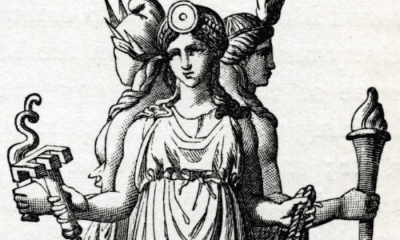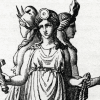Greek
Who Was Iris in Greek Mythology?
Iris was the rainbow goddess in Greek mythology, but her role went far beyond having a place in the sky. Keep reading to learn why the Greek goddess of the rainbow was the ideal messenger of the gods!
Hermes is known as the messenger of the gods. As Zeus’s personal herald, he flew around the world at top speed to deliver the words of the king of Mount Olympus.
Before Hermes, however, another deity filled this role. Iris was not one of the major gods of Mount Olympus, but she served the same important role as Zeus’s son.
In many stories it is the goddess of the rainbow, not the trickster thief, who delivers the messages of the gods. In stories such as the Iliad and the Aenead, Iris plays a pivotal role as a divine messenger.
Iris’s role as the goddess of the rainbow made her ideally suited for this position. Like many other cultures, the Greeks believed that the rainbow could connect the gods in the heavens with their worshipers on earth.
Iris the Rainbow Goddess
In Greek mythology, Iris was the goddess of the rainbow. While there is little evidence of a cult dedicated to her, she played an important role in many well-known stories.
Hesiod wrote that Iris had a twin sister named Arke. In the war between the Olympians and the Titans, each sister chose a different side.
Iris sided with Zeus and became his messenger, using her golden wings to fly between the gods. Her sister sided with the Titans and had her iridescent wings torn off after their defeat.
After the birth of Hermes, Iris lost her position as the personal messenger of Zeus. She continued to act for other deities, however, particularly Hera.
Iris had no mythology of her own. Instead, she appeared in other stories as a messenger between the gods and an intermediary between them and mortal men.
In the Iliad, for example, she relayed messages both to the humans and between the feuding gods. While she carries Zeus’s messages in this story, in the Odyssey the role of the messenger was taken by Hermes.
In one scene of the Iliad, Iris even acted as a charioteer to evacuate the wounded from the battlefield. When Aphrodite was wounded by Diomedes, Iris carried her to safety and drove her back to Olympus to be healed.
According to one account, she also played an important role in the birth of Apollo and Artemis.
Hera had prolonged Leto’s labor by keeping Eileithyia, the goddess of childbirth, from noticing that Zeus’s mistress needed her aid. The other goddesses who came to assist Leto sent Iris back to Olympus to bring Eileithyia to Delos without Hera’s knowledge.
While Iris worked against Hera’s schemes in this account, she was often seen as a close ally and companion of the queen of Olympus.
She is often shown in art at Hera’s side and working on her behalf. Roman art, in particular, often showed her in a multi-colored gown standing beside Hera’s throne.
In the Aeneid, Iris serves as the personal assistant of Juno, the Roman name for Hera, in her attempt to stop Aeneas from reaching Italy. Iris even plucks a hair from Dido’s head so she could die and go to the realm of Hades.
In addition to delivering messages from the gods, many Greeks believed that Iris could also deliver messages to them. Prayers and invocations often call on Iris to help the petitions of worshippers reach the ears of the Olympians.
My Modern Interpretation
As the goddess of the rainbow, Iris was ideally suited to be a messenger.
Even the Greek language seemed to recognize this. While iris meant “rainbow,” the similar-sounding eiris meant “messenger.”
Many cultures view the rainbow as a connecting point between the gods and mankind. The Norse, for example, envisioned it as the Bifrost bridge that linked Asgard to the world of men, Midgard.
The Greeks viewed the rainbow in the same way. Like many elements of nature, however, they personified it as a goddess.
Iris was given attributes that were fitting for the rainbow and helped her in her role as a messenger. For example, she moved so quickly that she could cross the world in seconds.
As a messenger, she was also one of the few beings that could freely cross between different realms. She could enter the realm of Hades and leave it as easily as she moved through the sky or traveled to and from Mount Olympus.
Iris could travel to the deepest parts of the sea and the highest reaches of the heavens, as well. Her golden wings brought light to even the darkest places so she could deliver messages from the gods without difficulty.
Iris’s role as a goddess who connected different realms was evidenced in her family lineage, as well.
According to Hesiod, she was the daughter of a sea god named Thaumis and an Oceanid, Electra. Although they were both sea deities, their daughters were not bound to the water.
While some legends claimed that Iris had a twin with similar attributes named Arke, Hesiod said that she was a sister of the Harpies. The bird-woman hybrids were monsters that flew above isolated islands in the Mediterranean.
The Harpies represented storm winds over the ocean, creating another link between the children of Thaumis and Electra and the sky. Iris was the beautiful rainbow that came after her sisters’ storms.
In at least one story, Iris even protected her more monstrous sisters. When they were pursued by the sailors of the Argo, Iris turned them back and commanded them to stop chasing after the Harpies.
Imagining the goddess of the rainbow as the offspring of sea deities probably arose from the geography of Greece.
Because many Greek communities were coastal, the sea was a major point of reference in their mythology. Rainbows in the area were most often seen over the water, appearing to connect the heavens to the sea rather than to earth as they did in many other cultures.
Iris was therefore not only a goddess of the rainbow. She was a goddess who connected the other Olympians to one another and the mortal people of earth by traveling freely between them.
In Summary
Iris was the goddess of the rainbow in Greek mythology. She personified the colors and light that appeared after a storm.
In many myths, she also served as a messenger of the gods. One story said that she took this role during the Titanomachy while her twin sister, Arke, chose to do the same for the Titans.
While Iris’s role as the messenger of Olympus was largely supplanted by Hermes, many legends still featured her performing this duty. During the events of the Iliad, for example, she not only relayed messages between the gods but also took injured gods back to Olympus for quick treatment.
Her position as the rainbow goddess made Iris an ideal messenger. Many cultures viewed the rainbow as a link between the realm of the gods and that of men.
The Greeks personified this connection, making the rainbow a messenger goddess and assistant to the gods rather than an inanimate bridge between worlds. As a winged goddess of the sky, Iris could travel as fast as light and reach any place.
This included other realms. Iris could move through the sea or the Underworld as easily as she did between Olympus and earth.
The Greeks imagined her as a daughter of sea deities, likely because the rainbow often appeared over the water in their experience. When this happened, they believed, Iris was relaying a message between the gods of the sea and their counterparts on Mount Olympus.



